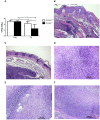TLR2-/- Mice Display Increased Clearance of Dermatophyte Trichophyton mentagrophytes in the Setting of Hyperglycemia
- PMID: 28164040
- PMCID: PMC5248405
- DOI: 10.3389/fcimb.2017.00008
TLR2-/- Mice Display Increased Clearance of Dermatophyte Trichophyton mentagrophytes in the Setting of Hyperglycemia
Abstract
Dermatophytosis is one of the most common human infections affecting both immunocompetent individuals and immunocompromised patients, in whom the disease is more aggressive and can reach deep tissues. Over the last decades, cases of deep dermatophytosis have increased and the dermatophyte-host interplay remains poorly investigated. Pattern recognition molecules, such as Toll-like receptors (TLR), play a crucial role against infectious diseases. However, there has been very little research reported on dermatophytosis. In the present study, we investigated the role of TLR2 during the development of experimental deep dermatophytosis in normal mice and mice with alloxan-induced diabetes mellitus, an experimental model of diabetes that exhibits a delay in the clearance of the dermatophyte, Trichophyton mentagrophytes (Tm). Our results demonstrated that inoculation of Tm into the footpads of normal mice increases the expression of TLR2 in CD115+Ly6Chigh blood monocytes and, in hypoinsulinemic-hyperglycemic (HH) mice infected with Tm, the increased expression of TLR2 was exacerbated. To understand the role of TLR2 during the development of murine experimental deep dermatophytosis, we employed TLR2 knockout mice. Tm-infected TLR2-/- and TLR2+/+ wild-type mice exhibited similar control of deep dermatophytic infection and macrophage activity; however, TLR2-/- mice showed a noteworthy increase in production of IFN-γ, IL-10, and IL-17, and an increased percentage of splenic CD25+Foxp3+ Treg cells. Interestingly, TLR2-/- HH-Tm mice exhibited a lower fungal load and superior organization of tissue inflammatory responses, with high levels of production of hydrogen peroxide by macrophages, alongside low TNF-α and IL-10; high production of IL-10 by spleen cells; and increased expansion of Tregs. In conclusion, we demonstrate that TLR2 diminishes the development of adaptive immune responses during experimental deep dermatophytosis and, in a diabetic scenario, acts to intensify a non-protective inflammatory response.
Keywords: Trichophyton mentagrophytes; deep dermatophytosis; hypoinsulinemia-hyperglycemia; monocytes; toll-like receptors.
Figures







Similar articles
-
IFN-γ impairs Trichophyton rubrum proliferation in a murine model of dermatophytosis through the production of IL-1β and reactive oxygen species.Med Mycol. 2014 Apr;52(3):293-302. doi: 10.1093/mmy/myt011. Epub 2014 Feb 13. Med Mycol. 2014. PMID: 24577006
-
Relationship among Short and Long Term of Hypoinsulinemia-Hyperglycemia, Dermatophytosis, and Immunobiology of Mononuclear Phagocytes.Mediators Inflamm. 2015;2015:342345. doi: 10.1155/2015/342345. Epub 2015 Oct 11. Mediators Inflamm. 2015. PMID: 26538824 Free PMC article.
-
Dectin-1 and Dectin-2 promote control of the fungal pathogen Trichophyton rubrum independently of IL-17 and adaptive immunity in experimental deep dermatophytosis.Innate Immun. 2016 Jul;22(5):316-24. doi: 10.1177/1753425916645392. Epub 2016 Apr 26. Innate Immun. 2016. PMID: 27189427
-
A Mouse Model of Trichophyton Inflammation Based on Trichophytin-induced Contact Hypersensitivity.Med Mycol J. 2019;60(3):65-70. doi: 10.3314/mmj.19.005. Med Mycol J. 2019. PMID: 31474692 Review.
-
[Immune response in dermatophytosis].Nihon Ishinkin Gakkai Zasshi. 2003;44(4):273-5. doi: 10.3314/jjmm.44.273. Nihon Ishinkin Gakkai Zasshi. 2003. PMID: 14615793 Review. Japanese.
Cited by
-
Skin Immunity to Dermatophytes: From Experimental Infection Models to Human Disease.Front Immunol. 2020 Dec 2;11:605644. doi: 10.3389/fimmu.2020.605644. eCollection 2020. Front Immunol. 2020. PMID: 33343578 Free PMC article. Review.
-
Antifungal activity of alexidine dihydrochloride in a novel diabetic mouse model of dermatophytosis.Front Cell Infect Microbiol. 2022 Sep 2;12:958497. doi: 10.3389/fcimb.2022.958497. eCollection 2022. Front Cell Infect Microbiol. 2022. PMID: 36118019 Free PMC article.
-
Sophorolipid Biosurfactant Can Control Cutaneous Dermatophytosis Caused by Trichophyton mentagrophytes.Front Microbiol. 2020 Mar 12;11:329. doi: 10.3389/fmicb.2020.00329. eCollection 2020. Front Microbiol. 2020. PMID: 32226417 Free PMC article.
-
TLR2-/- Mice Display Decreased Severity of Giardiasis via Enhanced Proinflammatory Cytokines Production Dependent on AKT Signal Pathway.Front Immunol. 2017 Sep 20;8:1186. doi: 10.3389/fimmu.2017.01186. eCollection 2017. Front Immunol. 2017. PMID: 28979269 Free PMC article.
-
Zoonotic and Anthropophilic Trichophyton mentagrophytes Complex Infection in Human: An Update and Narrative Review.Mycoses. 2025 Jun;68(6):e70082. doi: 10.1111/myc.70082. Mycoses. 2025. PMID: 40542551 Free PMC article. Review.
References
-
- Abd elaziz E. A. (2011). Pathological and biochemical studies on the effect of trigonella foenum -graecum and lupinus termis in alloxan induced diabetic rats. World Appl. Sci. J. 12, 1839–1850.
-
- Devaraj S., Tobias P., Kasinath B. S., Ramsamooj R., Afify A., Jialal I. (2011). Knockout of toll-like receptor-2 attenuates both the proinflammatory state of diabetes and incipient diabetic nephropathy. Arterioscler. Thromb. Vasc. Biol. 31, 1796–1804. 10.1161/ATVBAHA.111.228924 - DOI - PMC - PubMed
MeSH terms
Substances
LinkOut - more resources
Full Text Sources
Other Literature Sources
Medical

